
Maranoa Gardens began in the early 1890s, when Mr John Middleton Watson purchased 1.4 hectares in Balwyn, a suburb of Melbourne, Australia, for a private garden. He planted many Australian and New Zealand native trees and shrubs and the area was maintained purely as a garden. He named the gardens Maranoa after a river in Queensland, from native words meaning flowing, alive or running.
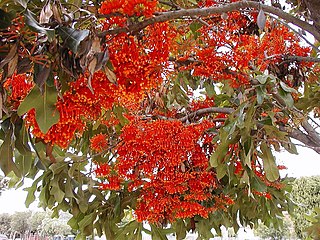
Stenocarpus is a genus of about 25 species of woody trees or shrubs, constituting part of the plant family Proteaceae.
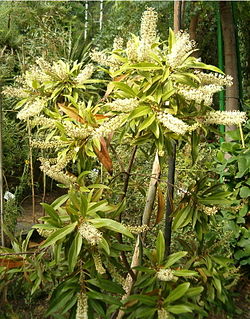
Buckinghamia is a genus of only two known species of trees, belonging to the plant family Proteaceae. They are endemic to the rainforests of the wet tropics region of north eastern Queensland, Australia. The ivory curl flower, B. celsissima, is the well known, popular and widely cultivated species in gardens and parks, in eastern and southern mainland Australia, and additionally as street trees north from about Brisbane. The second species, B. ferruginiflora, was only recently described in 1988.
Stenocarpus dumbeensis was a species of plant in the family Proteaceae. It was endemic to New Caledonia.
Stenocarpus heterophyllus is a species of plant in the family Proteaceae. It is endemic to New Caledonia. Also, it's threatened by habitat loss.
Stenocarpus villosus is a species of plant in the family Proteaceae. It is endemic to New Caledonia. It is threatened by habitat loss.

Cutis verticis gyrata is a medical condition usually associated with thickening of the scalp. People show visible folds, ridges or creases on the surface of the top of the scalp. The number of folds can vary from two to roughly ten and are typically soft and spongy. These folds cannot be corrected with pressure. The condition typically affects the central and rear regions of the scalp, but sometimes can involve the entire scalp.
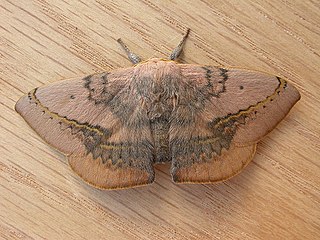
Anthela varia, the variable anthelid, is a moth of the Anthelidae family. The species was first described by Francis Walker in 1855. It is found in the coastal areas of southern Western Australia, southern Queensland, New South Wales, and Victoria.
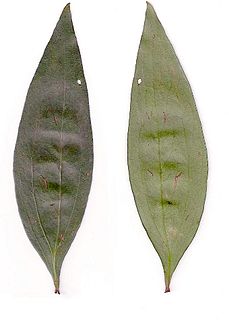
Stenocarpus salignus, known as the scrub beefwood is an Australian rainforest tree in the family Proteaceae. Found in warmer rainforests on the coast and ranges. It is often found in warm temperate rainforest on poorer sedimentary soils, or on volcanic soils above 750 metres above sea level. It was originally described by the botanist Robert Brown in 1810.
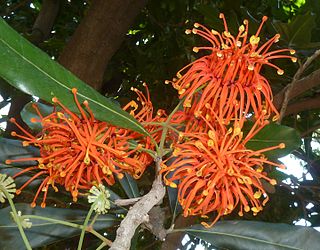
Stenocarpus sinuatus, known as the firewheel tree, is an Australian rainforest tree in the Protea family. The range of natural distribution is in various rainforest types from the Nambucca River in New South Wales to the Atherton Tableland in tropical Queensland. However, Stenocarpus sinuatus is widely planted as an ornamental tree in other parts of Australia and in different parts of the world.
Stenocarpus cryptocarpus, known as the giant leaf stenocarpus, is a species of trees, of the plant family Proteaceae. They are endemic to some rainforest parts of the wet tropics region of north eastern Queensland, Australia. Notably, juvenile leaves of young trees may reach 115 cm (4 ft) in length.

Stenocarpus umbelliferus is a species of flowering plant in the family Proteaceae. It is endemic to New Caledonia. It has a prostrate or upright habit, growing up to 5 metres in height. Stems are flattened when young, later becoming rounded. The leaves are thick and leathery with a slightly wavy margin. These may be ovate, elliptic, lanceolate or spathulate in shape with petioles that are 3 to 12 mm long. White, cream or pale yellow flowers occur in groups of 3 to 8 per umbel. These are followed by dark-coloured glabrous follicles that are 25 to 80 mm long and 3 to 5 mm wide.
Rosenthal–Kloepfer syndrome, is a cutaneous condition characterized by abnormal growth of bone and skin, coupled with clouding of the cornea. It was described in 1962. Another name for the condition is Acromegaly-cutis verticis gyrata-corneal leukoma syndrome.

Acrocercops chionosema is a moth of the family Gracillariidae. It is known from Queensland and New South Wales, Australia.
Stenocarpus acacioides is a tree of the family Proteaceae native to the Northern Territory and Western Australia.
Stenocarpus angustifolius is a tree of the family Proteaceae native to Queensland.
Stenocarpus cunninghamii is a tree of the family Proteaceae native to the Northern Territory and Western Australia.

Stenocarpus davallioides, commonly known as the fern-leaved stenocarpus, is a tree of the family Proteaceae native to the Australian state of Queensland.
Stenocarpus reticulatus, commonly known as black silky oak, is a tree of the family Proteaceae native to the Queensland.

Stenocarpus trinervis is a species of rainforest tree in the family Proteaceae, endemic to New Caledonia. It may grow to 20 metres in height. The timber is beautifully marked, suited to cabinet making.










